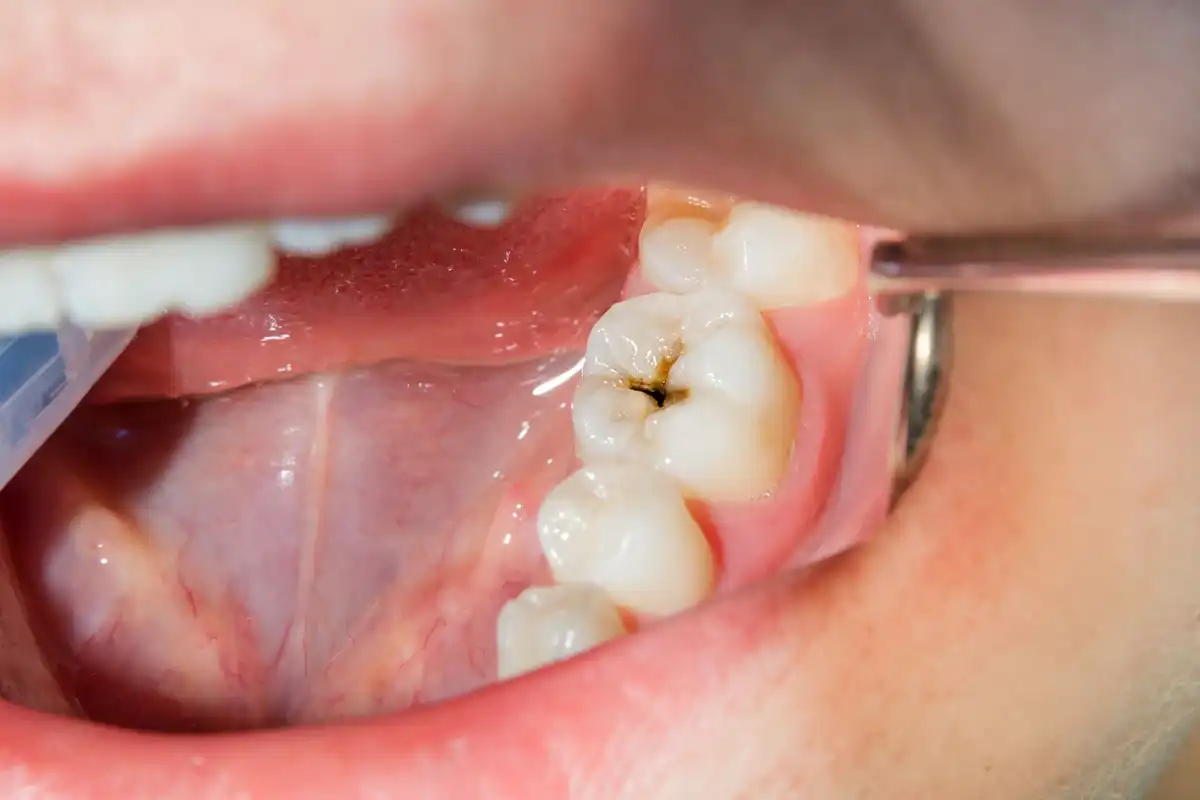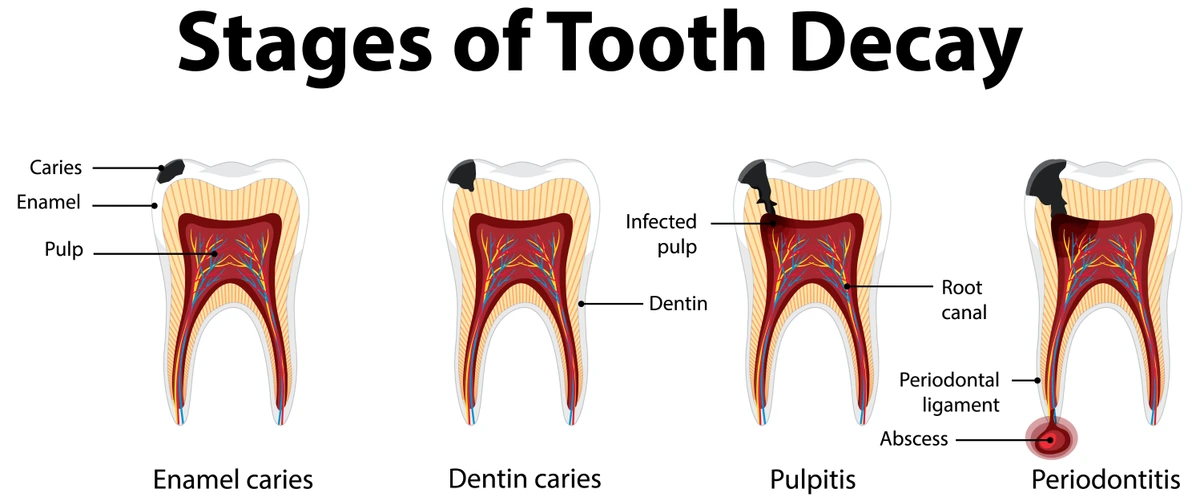Wait, Can Cavities Go Away on Their Own?


How quickly should you treat a cavity? Is it possible for an untreated cavity to stay there and not cause any problems? Can cavities go away after a while? Understanding the tooth decay process can help you minimize your dental expenses without putting your other teeth at risk. But to do that, you’ll need to understand the various stages of cavity formation and how cavities work once they get inside your teeth. That way you can best determine when to watch an untreated area of tooth demineralization as opposed to getting a cavity filled ASAP.
What Is A Cavity?
Tooth decay—aka “caries” or a cavity—is a bacterial infection inside of your tooth. Left untreated, a cavity will continually spread and expand into the neighboring tooth structures. This could be the same tooth or even adjacent teeth that are touching your decaying tooth.
A cavity starts out as weak, demineralized tooth enamel. Demineralization is caused by plaque buildup that isn’t removed from your teeth every day. So, the acidic plaque biofilm starts to etch away or eat your tooth enamel. At a certain point, the tooth enamel is compromised and a physical hole forms in your tooth. Before that, it’s a weak white spot because of all the missing minerals.
Can Cavities Go Away On Their Own
Left alone, untreated cavities don’t “heal” themselves. Since there are active bacteria inside of your tooth and the enamel is disintegrating and being eaten away, it can’t grow itself back. And once decay ruptures through your enamel into the second layer of your tooth—the dentin—it can spread even more quickly. Dentin isn’t as dense as enamel, so it tends to be softer and more cavity prone.
Whenever you brush your teeth that are starting to demineralize, you remove the biofilm that’s eating away at your enamel. And when you put fluoride toothpaste or gel back into the tooth, you can remineralize the weak areas and stop the decay process. There isn’t a hole just yet, but you will have a little scarring in your tooth that looks like white spots.
Can cavities go away on their own? No. But you can stop the first stage of decay with good oral hygiene. Once a cavity breaks through your enamel and physically reshapes your tooth, your only option is to see a dentist. It is physically and scientifically impossible for the tooth to re-grow in that space.
What Happens If A Cavity Is Left Untreated?
Most bacterial infections in your body can heal themselves or be treated with an antibiotic. But what about an untreated cavity? Unfortunately, when you have a cavity there is no way to reverse it on your own. The only option is to have your dentist physically remove the decay and fill the area to prevent further tooth breakage.
But if your tooth doesn’t hurt, you might be really tempted to not do anything about it. What happens if you have an untreated cavity in your mouth? It eventually spreads. There are 5 main stages of tooth decay, demineralization, enamel decay, dentin decay, pulp decay, and dental abscess formation. Depending on what stage you are at, you may be dealing with the following side-effects:
1. Infection
Technically, cavities are bacterial infections inside your tooth. The bacteria eat away at your enamel, create acid byproducts, and invite more bacteria into that space, making the cavity even larger. When the decay goes unaddressed, it just gets bigger and bigger and bigger. At a certain point, the decay will be so large that there’s just not enough tooth structure left to place or hold a filling. If you’re lucky, you can cover the tooth with a crown. But if you wait too long and the infection works its way into the nerve, you’ll need a root canal AND a crown.
Worst case scenario, an untreated cavity will eventually lead to total tooth loss. Because at some point, there just won’t be enough tooth anatomy left to repair or support a restoration.
Common symptoms of an active cavity infection include tooth sensitivity, pain, or visible holes in your teeth.
2. Nerve Damage
Untreated cavities almost always make their way into the nerve inside the middle of your tooth. Unfortunately, there is no way to treat and heal tooth nerves. The only option left to avoid an extraction is to remove the nerve and fill the chambers to seal off the tooth. We call this process endodontic therapy, aka root canal treatment.
Sure, you could take an antibiotic to alleviate initial pain and swelling. But the open decay will only cause the nerve to continually get re-infected. And when the nerve dies, it causes a slow deterioration inside the middle of the tooth. Your tooth is basically eating itself from the inside, out. There could be severe pain, mild sensitivity, or no symptoms at all. Tooth nerves are funny like that.
3. Jaw Damage
Whenever bacteria invade your tooth and dental nerve, they also spread into the bone that’s immediately surrounding your tooth root. For instance, when an abscess develops, it destroys the bone in that space where the cyst forms and drainage accumulates.
4. An Abscess
5. Death
This one sounds a little extreme, but I promise you it’s not unheard of. When someone—particularly children—has aggressive tooth decay and abscesses, the infection can spread into their bloodstream. In rare situations, it has even been known to cause brain infections. Hospitalization is required, as well as intravenous medication. At this point, your cavity becomes so life-threatening that it can actually cause death.
Unfortunately, some parents don’t realize that even though their child’s baby teeth are going to fall out, they play a huge role in their child’s overall health. Do not, under any circumstances, ignore your child’s cavities just because those teeth are temporary. It could wind up being one of the biggest mistakes you ever make.
Stages of Tooth Decay

Tooth Decay Prevention
To prevent the formation of cavities and stop them from spreading, good oral hygiene is an absolute must. That means physically disrupting plaque biofilm on your teeth by brushing your teeth twice a day and flossing once a day to prevent cavities.
You can also help prevent cavities by avoiding starchy and sugary foods. Tooth decay thrives when it can feed off sugars and starches from the foods you eat.
See your dentist every six months for checkups and cleanings. They and your hygienist will help you screen for areas of concern and develop a hygiene plan to reduce your cavity risk. But if you do have an untreated cavity, they can fill it ASAP while it’s still small and before it spreads into other areas.
Talk to your Dentist
If you’ve heard people claim to re-grow their teeth where they have a cavity, take it with a grain of salt. The cells that make up tooth enamel are physically incapable of regrowing themselves. If you have an untreated cavity, you need to see a dentist ASAP before it gets bigger and causes more serious oral health issues. But you can get cavities to go away if you interrupt them during the earliest stage of tooth demineralization.
Always be sure to see your dentist and hygienist for six-month checkups, to stop and reverse the tooth decay process before it creates a hole in your tooth!

Make your inbox smile!







